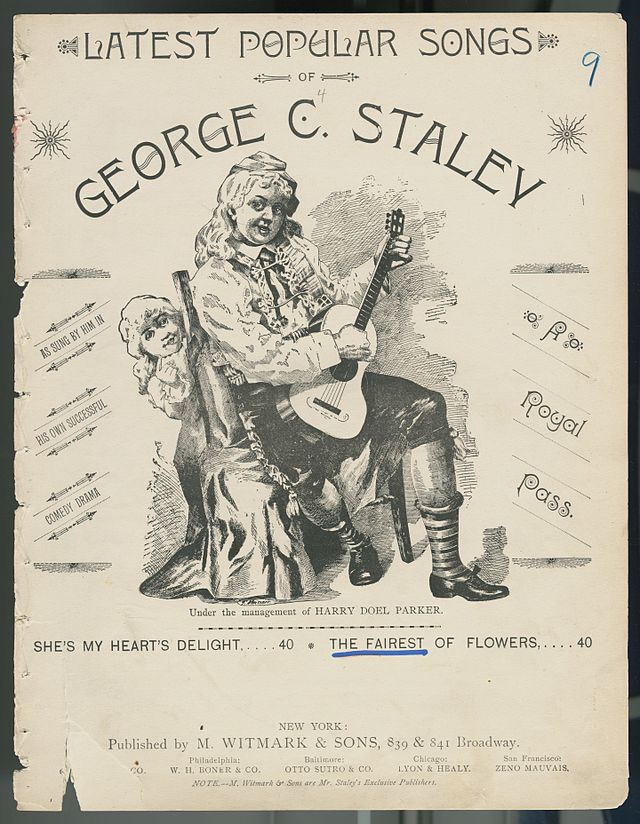Top Qs
Timeline
Chat
Perspective
M. Witmark & Sons
From Wikipedia, the free encyclopedia
Remove ads
M. Witmark & Sons was a leading publisher of sheet music for the United States "Tin Pan Alley" music industry.

Origins
Summarize
Perspective
After winning a toy printing press from school, the Witmark brothers (Isidore, Julius and Jay) opened a printing establishment in their home on West 40th Street in New York City, making Christmas cards. To augment his earnings, Jay began performing ballads in minstrel and variety shows and later decided to publish music.
The firm of Marcus Witmark & Sons was established in New York City in 1886. The father, Marcus Witmark, was the legal head of the company; but from the beginning it was run by his sons Isidore, Julius, and Jay, who were under legal age when the company started (ranging in age from 17 to 14 years old). They started out publishing their own compositions. They were adept at plugging songs, and within a few years were publishing the works of such composers as Victor Herbert, George M. Cohan, Louise Christine Rebe, Ben Harney, Pauline B. Story, and John Walter Bratton.
In 1888, M. Witmark & Sons LP relocated to 32 East 14th Street in Manhattan, becoming the first music publisher to settle into the theatre district. Isadore found the contracts, and Julius sang and demonstrated the songs, thereby becoming the first song pluggers in the young industry. Some of the publisher's early hit songs included "After the Ball" by Charles K. Harris and "Sweet Adeline" by Harry Armstrong and Richard H. Gerard.
Witmark originated the practice of giving free "professional copies" of their new music to famous and established singers and bands, which proved so successful an advertising method that it was copied by the rest of the music publishers.
When the International Copyright Law was passed in 1891, Witmark pioneered publishing versions of British music in the United States and arranging for American hits to be published in the UK.
Remove ads
Family
| Witmark Family | ||||
| Relationship | Name | Birth | Death | Notes |
| Father | Marcus Witmark |
1834 Prussia |
Mar. 29, 1910 Manhattan |
Married Peyser Oct. 4, 1866 |
| Mother | Hennrietta Witmark née Peyser |
1840 Prussia |
Dec. 14, 1906 Manhattan |
|
| Son | Isidore Witmark |
1870 Manhattan |
Apr. 19, 1941 Manhattan |
|
| Son | Julius ("Julie") Peyser Witmark |
1871 Manhattan |
June 14, 1929 Manhattan |
|
| Son | Jacob ("Jay") Witmark |
Mar. 31, 1872 Manhattan |
Feb. 1950 Manhattan |
One of the nine founding members of ASCAP in 1914 |
| Son | Frank Morris Witmark |
1875 Manhattan[1] |
Aug 3, 1948 Weehawken, NJ |
|
| Son | Edward Witmark |
1877 Manhattan |
||
| Daughter | Frances Klein (Mrs. Joseph A. Klein) née Witmark | 1874 Manhattan |
1957 Manhattan |
Married Klein Jan. 11, 1905 Manhattan |
| Son | Adolph S. Witmark |
1882 Manhattan |
July 15, 1926 Manhattan |
|
Remove ads
Succession of ownership
Summarize
Perspective
- In 1922, Sargent Aborn (1867–1956), brother of Milton Aborn (1864–1933), both of the Aborn Opera Company, acquired the Arthur W. Tams (1848–1927) music library,[2] a collection that had become the largest circulating music library in the world — and by extension, Witmark's biggest competitor in the music-rental field. In January of 1925, M. Witmark & Sons acquired the music Tams library, ending 30 years of intense rivalry. The combined Tams-Witmark library, operating as the Tam-Witmark Music Library Inc. (a New York corporation) secured its position as the largest source of musical-comedy and operatic music for amateur and professional productions.[3] Sargent Aborn was president of Tams-Witmark from its founding until his death in 1957. In 1942, Sargent Aborn and his son, Louis Henry Aborn (1912–2005), acquired the rights to the Tams Library. As of 2014, the co-chairmen were Robert Aborn Hut (born 1935) and Sargent Louis Aborn (born 1948) and the executive vice-president was Peter Aborn Hut (born 1940). All three are grandchildren of Sargent Aborn. Tams-Witmark was acquired by Concord in 2018.
- In the 1960s, Tams-Witmark donated several lots of its old inventory to the special collections of five libraries known for music research: the Library of Congress, the Eastman School of Music, Westminster Choir College, and the largest part of its inventory to the University of Wisconsin–Madison, through the initiative of the Wisconsin Center for Film and Theater Research and the School of Music.
- The consolidation of Tams and Witmark mostly affected operatic music and musical theatre. It did not affect the separate concern of M. Witmark & Sons, music publishers, who continued publishing popular and classical music.[4]
- In 1929, M. Witmark was purchased by Warner Bros.[5] Warner Bros. merged its music publishing companies (which included Witmark, Remick, and Harms) into one company, Warner Bros. Music (now Warner/Chappell Music).
- In 2005, Alfred Music purchased Warner Bros. Publications — acquiring the publishing rights to Warner/Chappell Music and the EMI Music Publishing Catalogue Partnership. Through this deal, Alfred Music gained the print rights of publishers that include M. Witmark & Sons, Remick Music Corp., and T.B. Harms, Inc. Among the EMI holdings are the Robbins and Leo Feist catalogs, plus film music from United Artists, MGM, and 20th Century Fox.
Remove ads
See also
Competitor music publishing firms in Tin Pan Alley
- Leo Feist, Inc. – 231 W 40th St, New York, NY
- T.B. Harms & Francis, Day & Hunter, Inc. – 62 W. 45th St., New York, NY
- Shapiro, Bernstein & Co., Inc. – 218 W. 47th St., New York, NY
- Watterson, Berlin & Snyder, Inc. – 1571 Broadway, New York, NY (sold in bankruptcy to Mills Music in 1929)
References
External links
Wikiwand - on
Seamless Wikipedia browsing. On steroids.
Remove ads
